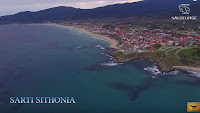Η Σάρτη βρίσκεται στις ανατολικές ακτές της χερσονήσου της Σιθωνίας συνδυάζοντας βουνό και θάλασσα.
Έχει βραβευτεί με την γαλάζια σημαία διότι έχει πολύ καθαρά νερά κάτι που σημαίνει ότι μπορείτε να κάνετε το μπάνιο σας και τις βουτιές σας άφοβα.
Διαθέτει φυσική ομορφιά με γραφικούς κολπίσκους και μια πεντακάθαρη θάλασσα η οποία έχει γίνει επιλογή από πολύ κόσμο για την διάρκεια των διακοπών τους.
Μπορείτε να κάνετε διάφορες θαλάσσιες δραστηριότητες όπως surfing και jet ski καθώς και άλλα πολλά τα οποία θα σας διασκεδάσουν.
Η φύση, το πράσινο και το γαλάζιο της θάλασσας είναι ένας υπέροχος συνδυασμός που θα σας γοητέψει.
Τα κρυστάλλινα πρασινογάλαζα νερά της θάλασσας, η λευκή άμμος, οι υπήνεμοι κολπίσκοι, οι μοναδικές ακτές που τις προφυλάσσουν γραφικοί βράχοι, συναρπάζουν τους επισκέπτες και προσφέρουν αξέχαστες στιγμές και εμπειρίες.
Από το λιμανάκι της Σάρτης ξεκινούν καθημερινά οργανωμένες θαλάσσιες εκδρομές για τον περίπλου του Αγίου Όρους, τη Βουρβουρού και παραλίες της περιοχής.
Sarti (Greek Σάρτη) is located centrally on the western coast of the Sithonia-peninsula in a distance of 150 km to Thessaloniki. Approximately 1150 inhabitants (status 2011) are living in this area all year around. The town was named after the historic King Sartis. Sarti is located on the place of the ancient city Sarte. In the 14th century the monastic-related village Sartis was established on the same location but abandoned again during the 17th century. 1922 the area was re-populated by Greek refugees who had to leave their origin home as a result of the defeat in the Greek-Turkish War.
The extensive landscape of Sarti extends northwards until the neighboring area Agio Nikolaos and borders south after the beach-area of Sykia. Westwards leads the field over the mountain-massif Itamos until the region of Neos Marmaras. The center of Sarti is located at the bay of Sarti on the singitish gulf. The large countryside of Sarti is mainly mountainous. Therefore agriculture is restricted on 2 usable plateaus.
The landscape of Sarti combines vast highlands, green hills, wide sandy beaches and secluded coves on crystal blue sea. In center and several locations outside the resort many traditional taverns take care of the visitor's well-being. Beach bars provide summer-feeling with exciting events. Beside the entertainment of an established holiday-resort, the wide coastline contains many secluded beaches and coves where visitors have the possibility to enjoy sea, sun and relaxation beyond touristic hustle & bustle. Benefited due the eastern position of Sarti and its coast, you can admire breathtaking sunrises over Mount Athos.
Few kilometers in east direction of Sarti is one of the most interesting beach-areas of Halkidiki: the 'Orange Beach', also known as 'Kavourotrypes' (Greek Καβουρότρυπες, crab holes). The crab-holes got the name due to many coves and hollows caused on erosion on the barren ground. The most famous natural formation of this beach is the coastal rock which has been honed by wind and water to a shape of a woman's body. In immediate vicinity more figures were carved out of the stones by local artists. Previously the location for a nude-community (the engraving of the nude-camp 'Dionysus' still can be seen), later occupied by flower people, this place hasn't lost any of its relaxing atmosphere and inspires the visitor with stunning nature naturalistic art.
Whether entertainment in various beach bars, exiting nightlife, relaxation on secluded coves, discovering the impressive mountainous landscape by hiking or visiting landmarks and cultural monuments; Sarti is a place where everyone has the chance to style an individual holiday experience.
The name of this new founded refugee settlement was originally Nea Afisa Greek (Νέα Αφησιά) in memory of the abandoned homeland Afisia, a small island in the inland-sea of Marmaras. It was established on the historic area Sarte. Between the 14th and the 17th century the place was used as a convent village named Sartis. Primary the refugees took shelter in the still existing ruins of the abandoned village. Finally the village was named Sarti referring to its historic relation.
Until the construction of the ring-road in Sithonia in the sixties to establish a connection to the road-network of Halkidiki, Sarti remained highly isolated. At this time this village was only accessible by boat. The residents of this secluded community were dealing primarily with fishing and agriculture. The result of the completion of the road was a significant economic revival and the area developed towards tourism.
In consequence to the connection to the street-network the port of Sarti lost on importance and was used exclusively as a fishing port further on. It's also the starting point of various touristic boat trips.
Music "Soar" Scott Buckley


